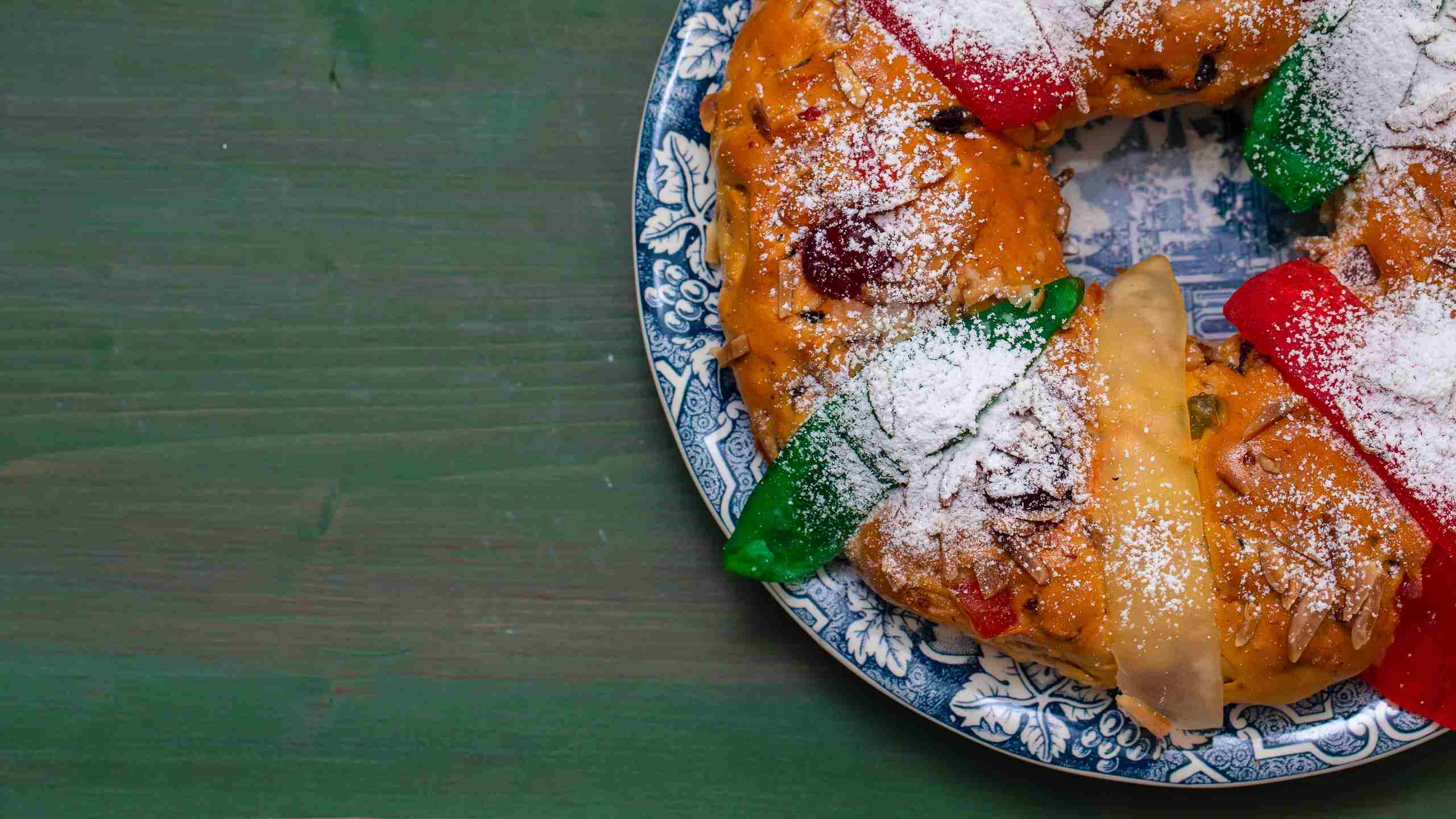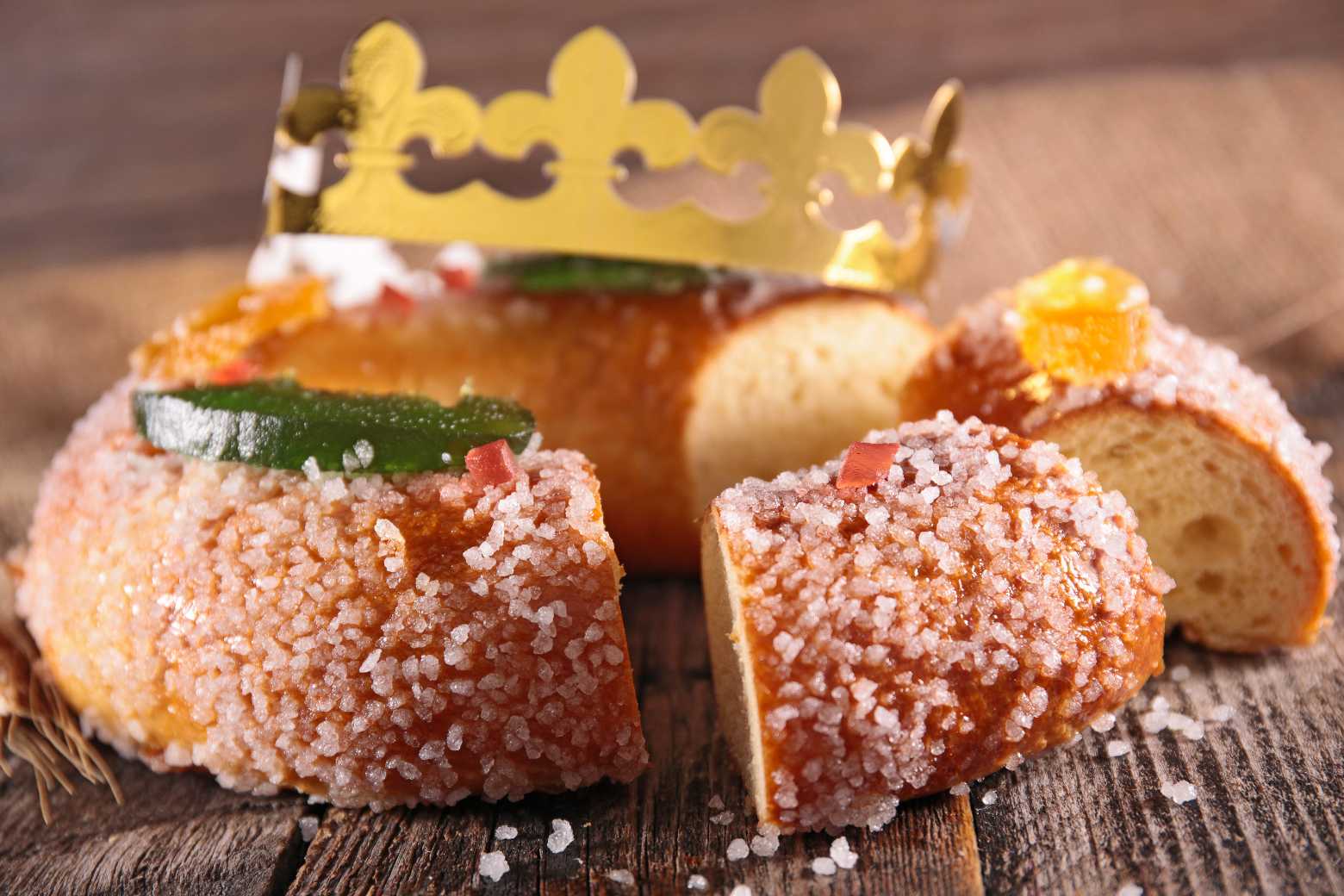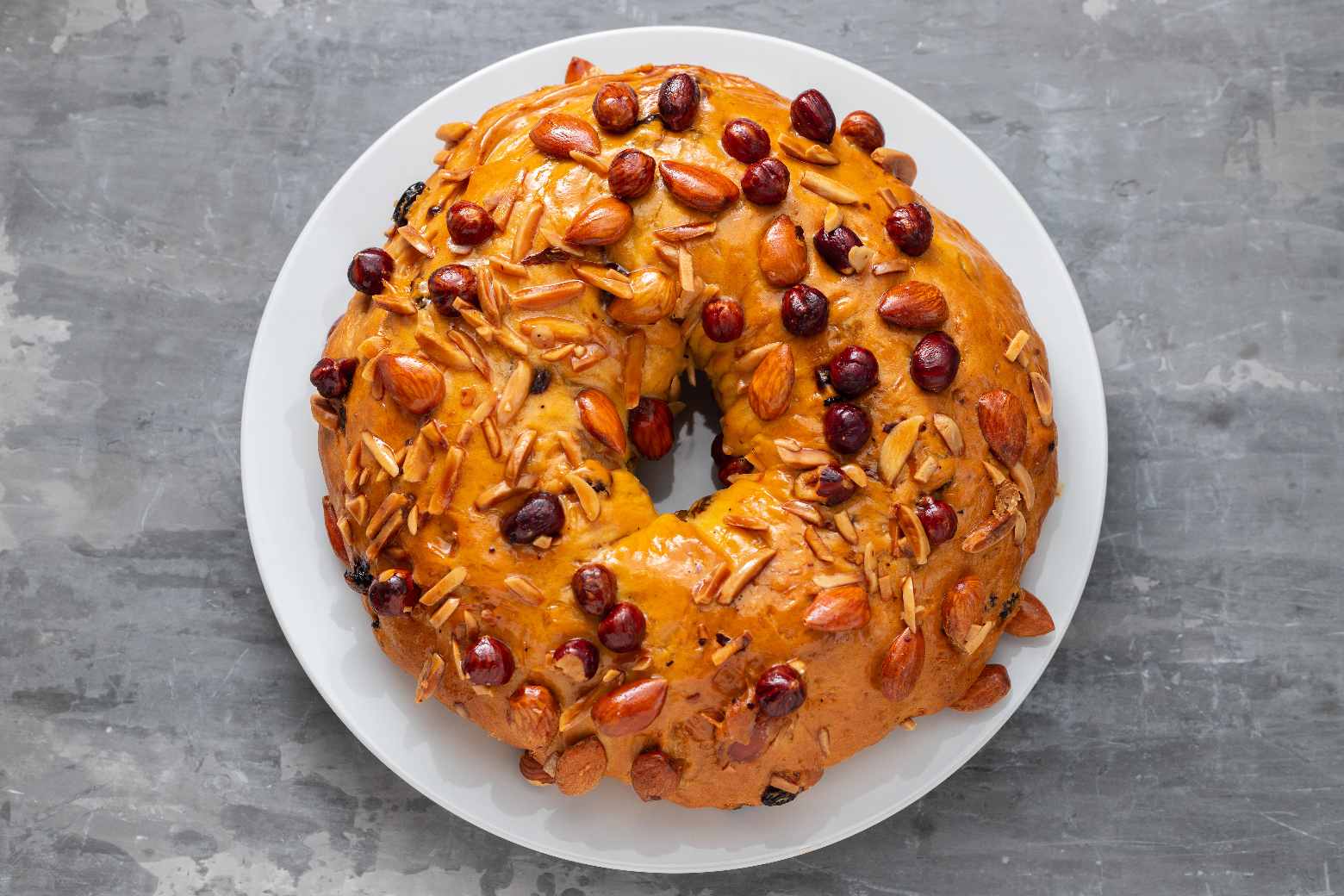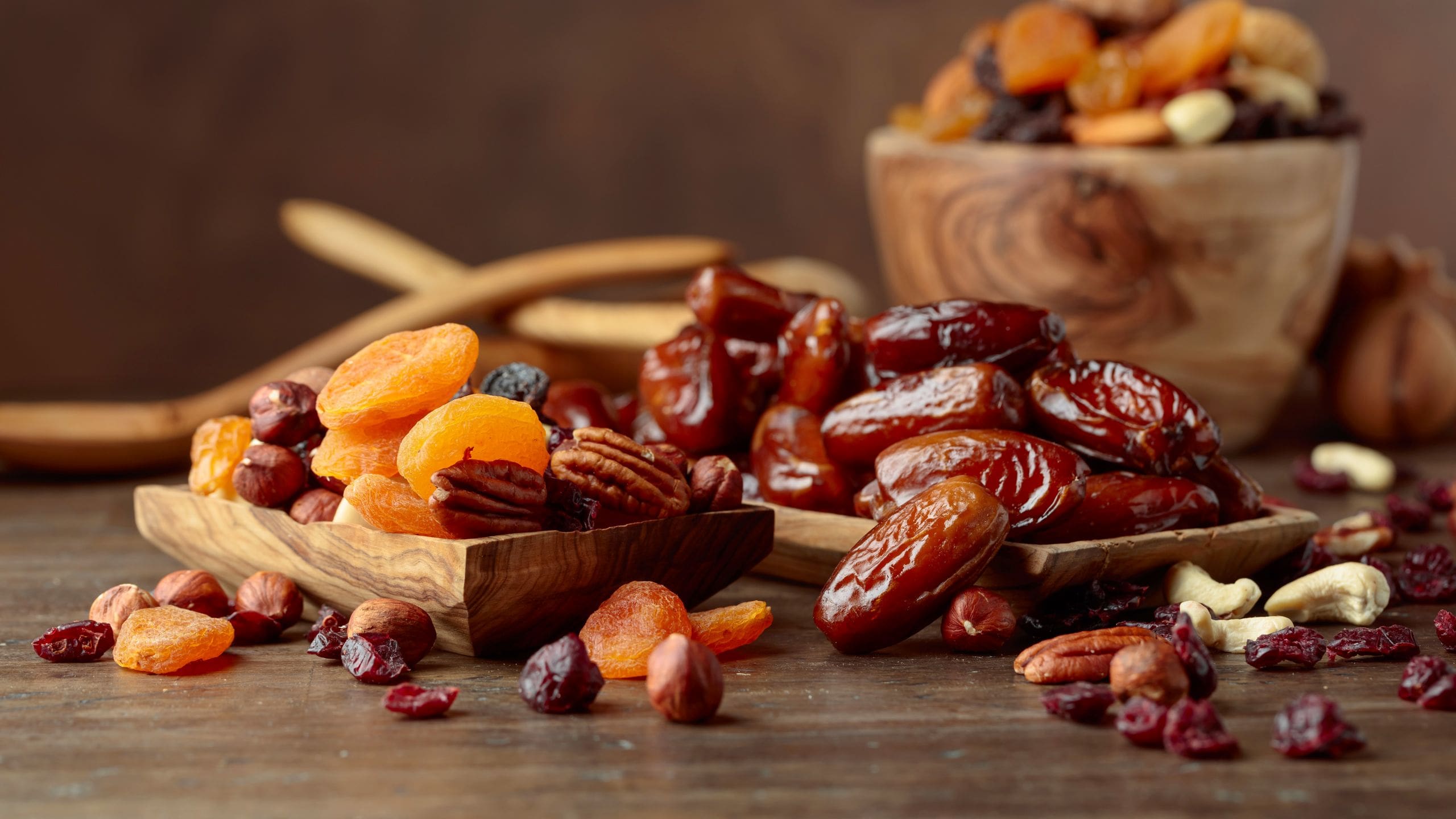
Bolo-rei, the king of cakes is Christmas on a plate
More than Christmas trees or even presents, the holiday season in Portugal is all about sharing food with loved ones. Discover the history and origin of bolo-rei (you might know it as King Cake), the star of Christmas supper and a token of tradition.
Bolo-rei, symbol of Christmas and tradition
Bolo-rei (literally, King Cake) is for Christmas what ice-cream is for summer. Simply put, Portuguese Christmas is not complete without it. Just like any other guest that joins the table, year after year, this “old friend” needs no introduction – or does it?
As it turns out, the origin story of bolo-rei is wrapped in mystery and myth. So, come along and get ready for a delicious Christmas tale.
The history and origin of the King Cake
All is bright during the holiday season, and the King Cake is no exception. Shaped as a crown and adorned with nuts and crystallised (candied) fruits, with a soft, airy, flavourful dough, and topped with powdered sugar, the King Cake is a delight for the eyes and for the palate. This delicatessen became a Christmas tradition and has been deeply rooted in the Portuguese culture for over a century. Although it is hard to pinpoint its origin exactly, history and legend have common elements: France, the Three Wise Men, and the Roman era.
Let’s break it down into small parts.
It all began in France at the end of the 19th century with the gâteau des rois (cake of the kings). This typical French cake was eaten at New Year’s Eve and on the Feast of the Three Kings celebrations (January 6th), especially in the south and southwest of the country. On a visit to France, the son of the founder of the iconic Confeitaria Nacional, in downtown Lisbon, was amazed by the cake and hired Gregoire (or Gregório, as he became known by the Portuguese), a French pastry chef, to adapt the recipe for the gâteau des rois. In 1869, Confeitaria Nacional became the first confectionery in Portugal to sell the King Cake the Portuguese people know and love today. Following the onset of the Portuguese Republic, in 1910, an attempt was made to replace the term “king” with “president”, but to no avail – “bolo-presidente” (President Cake) failed to catch on and “bolo-rei” regained its place at the table.

Gâteau des rois
The gâteau des rois, in turn, dates back to the Roman era, more precisely to the Saturnalia festivity, celebrating Saturn (the Roman god of abundance), that took place around the winter solstice. It is believed that this is also the origin of the Spanish roscón de reyes, typically enjoyed on the Twelfth Day, 5th of January, and the following day, the Day of the Three Kings (also known as Wise Men, or Three Magi).
Over the years, the different versions of this cake have been attributed to the Christian legend of the Three Wise Men (Balthasar, Caspar, and Melchior). This association has spread to countries with a Christian tradition, such as Germany and Switzerland, where it is referred to as dreikönigskuchen (cake of the three kings).
There is another common element, be it Christmas Day, New Years’ Day, or The Three King’s Day, whether in Portugal, France, Spain or anywhere else. The King Cake (and its counterparts) stand for moments of joy, in which families and friends share, celebrate, and spend time together.
Who gets to be this year’s King?
What makes the King Cake so special goes beyond flavour and tradition – it is all about the memories. Until a few years ago, the King Cake – as well as the Roscón de Reyes or the Gateâu des Rois – used to have a small fève inside, baked into the dough. The fève (from the French word for fava bean) is a small trinket or favour, usually a figurine or pendant made of porcelain, metal, or plastic, and in the shape of something fun like a star, a shoe, a hat, or even a little soldier. The lucky one to find the fève in their slice of cake would be “crowned” king or queen of that year.
In Portugal, besides the fève (brinde), the King Cake used to have an actual dried fava bean, and the not-so-lucky one to find it would have to pay for the next year’s King Cake. Nevertheless, finding either the fève or the fava were special moments of laughter and joy.
Both the use of the fève and the fava bean were abandoned for safety reasons.
Types of King Cake
It is now possible to find several types of King Cake:
- Traditional King Cake: made with sourdough, nuts, and dried and candied fruits;
- Bolo-rainha: Queen Cake, similar to King Cake but without candied fruit, only with nuts and dried fruits, mainly raisins and sultanas;
- Chocolate King Cake: with melted chocolate baked into the raw dough, sweeter than the traditional cake;
- King Cake with sweet egg yolk cream: this King Cake’s dough is filled with this cream, but otherwise similar to the traditional cake;
- Salty King Cake: a less popular variant, in which the dough is savory instead of sweet, and is adorned with cold cuts, charcuterie, olives, and almonds.
- “Escangalhado” King Cake: “escangalhado” means broken or dishevelled – but there is nothing wrong with this delicious treat. This recipe has a rich filling of jam, pastry cream, and dried fruits. Its “broken” shape stands out – it features irregular layers of dough and overflowing filling.

Bolo-rainha (Queen Cake)
How to bake a King Cake
If you have the time and the will to get your hands “dirty”, we suggest a delicious traditional King Cake recipe to enjoy this Christmas:
Ingredients:
- 100 g walnuts
- 50 g powdered sugar
- 100 g golden sultana
- 100 g sliced almonds
- 175 g candied fruits (pumpkin, pineapple, orange peels, cherries, figs, pears, etc)
- 100 g pine nuts
- 1 tsp. salt
- 1 lemon (zest)
- 1 orange (zest)
- 4 eggs (medium size) + 1 egg yolk
- 150 g sugar
- 150 g margarine
- 750 g plain flour
- 30 g baker’s yeast
- 1dl Port wine
Preparation:
- Chop about 100g of the candied fruits, and leave some aside, whole, to decorate.
- Mix the chopped candied fruits and marinate them in the Port wine.
- Dissolve the baker’s yeast in 1 dl of warm water and add a cup of flour. Mix well, cover with cling film, and leave to rise in a warm place for 15 minutes.
- Mix in the margarine with the sugar and add four eggs one by one.
- Add the lemon and orange zest. Add the yeast mixture (after leavened).
- Add the remaining flour and salt. Mix the dough well until the mixture is elastic and soft.
- Add the macerated fruits and knead again.
- Chop some dried fruits and nuts and incorporate into the dough. Put some aside for decoration.
- Shape the dough into a ball, sprinkle it with flour and cover it with cling film, leaving it to rise for 3 hours or until it doubles in volume.
- Place the dough on a baking tray lined with parchment paper and make a hole in the centre. Preheat the oven to 180 °C.
- Brush the cake with beaten egg yolk and decorate the entire surface with the remaining candied fruits, dried fruits, and nuts.
- Place the powdered sugar in three mounds on the cake and bake for 35 to 45 minutes. Let cool before serving. On average, this king cake will make 15 servings.
King Cake: ingredients, tips, and variations
With small modifications, you can make the King Cake recipe healthier, vegan, or suited for those with lactose-intolerance:
- Candied fruits have added sugar – reduce the amount used or add, in alternative, seeds and freeze-dried fruits, such as goji berries or pumpkin seeds;
- If you’re using powdered sugar just for the sake of aesthetics, maybe try baking the cake without it;
- Mix in different flours, like wholewheat, oat or spelt flour, for a more complex nutritional profile;
- Reduce the amount of sugar;
- Instead of margarine, try using olive oil;
- Salt can enhance some of the flavours, but there are possible substitutes – such as cinnamon or fennel;
- For a vegetarian or vegan option, replace milk with plant-based alternatives and choose alternatives for the eggs;
- If you have celiac disease, are gluten intolerant, or if you just want to avoid this protein, try a gluten-free King Cake. To do so, replace traditional flours with gluten-free options, like rice or almond flour. Otherwise, you can still use crystallized and dried fruits, in the filling and for decoration.
These are just suggestions – rather than restrictions, the answer to healthy eating is moderation. After all, what really matters during the festive season is spending happy (and sweet) moments around the table.
How to make the most of King Cake leftovers
Too many leftovers? Not one bit goes to waste! If the King Cake becomes dry after a few days, just pop some slices in the oven for a few minutes, or in the toaster, and eat it warm and slightly crunchy. You can also make bread pudding, or even a different kind of French toasts. And if you want to give your friends and family DIY Christmas gifts, make mini king-cakes. If you feel like having a slice of King Cake on hand for the following months, freeze the leftovers.
Bolo-rei Pingo Doce: tradition with a sprinkle of novelty
Are you spending the Christmas holidays in Portugal? Then head over to a nearby Pingo Doce store and try a King Cake’s special edition. In a unique partnership, Pingo Doce has teamed up with 100-year-old Pastelaria Versailles to create a true delight: the Pingo Doce Versailles King Cake. Baked everyday in the stores, its pastry is fluffy and light, filled with candied fruit, pine nuts, walnuts, almonds and hazelnuts.
If you prefer an option without candied fruit, bolo-rainha (Queen Cake, in English) is a great Christmas choice. With a similarly light and fluffy dough, this variation has plenty of dried fruits, which give it a crunchy texture.
Alternatively, mix things up with the apple and caramel King Cake, a limited edition for this Christmas. It’s filled with apple and salted caramel, topped with walnuts and salted caramel, providing a balanced flavour between the sweetness of the apple and the salty kick from the caramel. Not to be missed!


